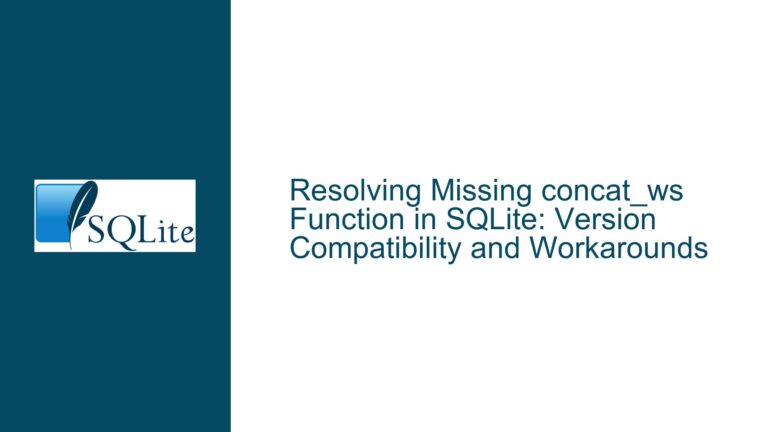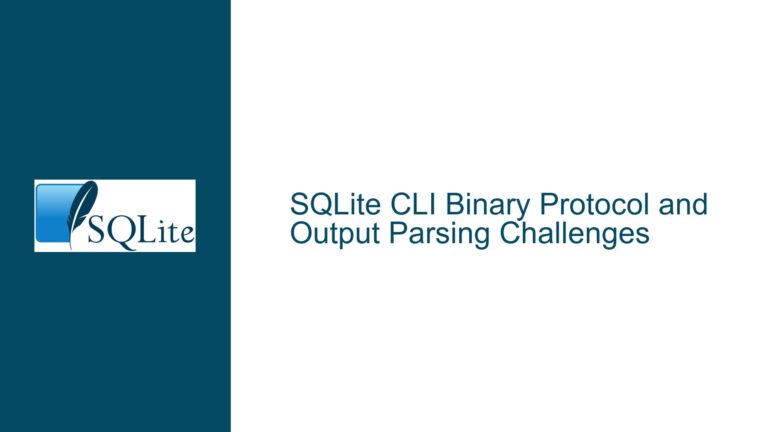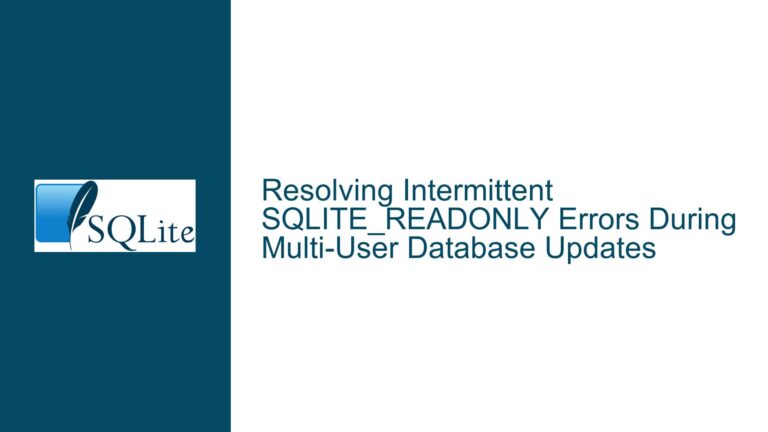SQLite Graph Query Support: Current Limitations and Workarounds
Understanding SQLite’s Position on Graph Query Language (GQL/SQL-PGQ) Adoption
The question of whether SQLite will adopt support for graph query languages such as GQL (Graph Query Language) or SQL/PGQ (Property Graph Queries) revolves around SQLite’s design philosophy, technical constraints, and the practical realities of maintaining a lightweight, embedded database engine. SQLite has long prioritized minimalism, portability, and simplicity, which has made it the most widely deployed database engine globally. However, these priorities inherently conflict with the complexity of implementing graph-specific querying capabilities.
Graph databases and their query languages (e.g., Cypher, GQL) focus on traversing relationships between entities using pattern-matching syntax, recursive pathfinding, and edge-oriented operations. These features are fundamentally different from SQLite’s relational model, which relies on joins, indexes, and structured schemas. The ISO/IEC working groups’ efforts to standardize SQL/PGQ aim to bridge this gap by extending SQL with graph constructs. However, integrating such extensions into SQLite would require significant changes to its parser, query planner, and virtual machine (VDBE), all of which are tightly optimized for relational operations.
SQLite’s developers have consistently emphasized that the project avoids adding features that could bloat the codebase, increase maintenance overhead, or compromise its suitability for embedded systems. This stance is evident in historical decisions to reject proposals for stored procedures, custom functions requiring runtime interpretation, and other "nice-to-have" features that diverge from its core mission. The absence of a plugin architecture or extensible parser further complicates the adoption of graph query syntax.
Critically, SQLite’s use case as a serverless, single-file database makes it ideal for applications needing local storage without external dependencies. However, this design also limits its ability to support complex graph traversal optimizations, which often rely on specialized indexes (e.g., adjacency lists, edge properties) and in-memory processing. While relational databases can simulate graph operations through recursive common table expressions (CTEs) or nested joins, these methods are verbose and performance-intensive compared to native graph queries.
Challenges and Technical Constraints Preventing Native GQL/SQL-PGQ Implementation
The technical barriers to implementing GQL or SQL/PGQ in SQLite fall into three categories: architectural incompatibility, resource limitations, and philosophical alignment.
Architectural Incompatibility
SQLite’s query execution pipeline is optimized for relational algebra. The parser, tokenizer, and VDBE are designed to process SQL statements into bytecode that operates on tables and indexes. Graph queries, by contrast, require a fundamentally different execution model. For example, a traversal likeMATCH (A)-[:IS_IN*1..3]->(B)involves recursively following edges up to three levels deep, which cannot be efficiently translated into SQLite’s join-centric execution plan without introducing new bytecode operations or intermediate representations.The SQL/PGQ standard proposes augmenting SQL with graph constructs, but this would necessitate modifying SQLite’s Lemon parser grammar, which is statically compiled. Unlike databases with modular parsers (e.g., PostgreSQL), SQLite cannot dynamically load syntax extensions. Rewriting the parser to support graph clauses would increase code complexity and introduce risks of breaking backward compatibility.
Resource Limitations
SQLite’s binary footprint is deliberately kept small (under 1 MB in some configurations) to accommodate resource-constrained environments. Adding graph query support would require embedding additional components such as:- A pattern-matching engine for graph traversal.
- Metadata tables to track edge/vertex relationships.
- Optimizations for recursive queries (e.g., cycle detection, depth limits).
These features would inflate the library size and memory usage, conflicting with SQLite’s goal of being a lightweight embeddable engine. Even optional compile-time flags (e.g.,
-DSQLITE_ENABLE_GRAPH_QUERIES) would fragment the codebase and complicate long-term maintenance.Philosophical Alignment
SQLite’s developers have repeatedly stated that the project prioritizes reliability and stability over feature breadth. Introducing graph query capabilities would require ongoing maintenance to align with evolving ISO standards, implement performance optimizations, and address edge cases in graph traversal logic. Given the niche demand for graph features in SQLite’s primary use cases (mobile apps, IoT devices, embedded systems), such efforts are deemed disproportionate to their perceived benefits.Moreover, the relational model is Turing-complete and capable of representing graph structures through adjacency lists or closure tables. While querying such representations is less elegant than using GQL, it avoids the need for engine-level changes. SQLite’s maintainers argue that developers should leverage existing SQL features or external tools rather than expecting the database to natively support every emerging paradigm.
Alternative Strategies for Graph Query Functionality in SQLite Environments
Despite the absence of native GQL/SQL-PGQ support, developers can implement graph-like querying in SQLite through a combination of schema design, SQL extensions, and external tooling. Below are practical approaches to bridge the gap:
Recursive Common Table Expressions (CTEs)
SQLite supports recursive CTEs, which enable querying hierarchical or graph-structured data stored in adjacency list format. For example, consider a tableedgeswith columns(from_node, to_node, relationship):WITH RECURSIVE traverse_path AS ( SELECT from_node, to_node, relationship, 1 AS depth FROM edges WHERE from_node = 'A' UNION ALL SELECT e.from_node, e.to_node, e.relationship, tp.depth + 1 FROM edges e JOIN traverse_path tp ON e.from_node = tp.to_node WHERE tp.depth < 3 -- Limit traversal depth ) SELECT * FROM traverse_path;This query emulates a depth-limited traversal starting from node ‘A’. While effective for simple graphs, recursive CTEs lack optimizations like bidirectional search or cycle avoidance, leading to performance degradation in complex graphs.
Virtual Table Extensions
SQLite’s virtual table API allows developers to create custom table implementations that intercept read/write operations. A graph virtual table could expose edges and vertices as queryable objects while translating graph operations into optimized SQL behind the scenes. For instance, agraph_vtabmodule could parse Cypher-like queries and generate appropriate joins or recursive CTEs.The statement_vtab extension demonstrates how value-enabled tables can dynamically generate SQL. A similar approach could map graph patterns to relational queries. However, this requires significant development effort and may not match the performance of native graph databases.
Transpilation Layers
External tools can convert graph queries into SQLite-compatible SQL. For example, Microsoft’s openCypher-to-SQL transpiler (referenced in the forum thread) parses Cypher queries and emits equivalent SELECT statements with joins and CTEs. This approach leverages SQLite’s existing capabilities while abstracting the complexity of manual query construction.To use such a transpiler:
- Annotate foreign key constraints or junction tables with JSON comments indicating edge semantics (e.g.,
/* {Label:"IS_IN"} */). - Use the transpiler to convert a Cypher query like
MATCH (a:City)-[:IS_IN]->(b:Country)into:SELECT a.*, b.* FROM City a JOIN Country b ON a.country_id = b.id;
This method requires preprocessing the schema to capture graph metadata but avoids modifying SQLite itself.
- Annotate foreign key constraints or junction tables with JSON comments indicating edge semantics (e.g.,
Hybrid Applications
Applications can combine SQLite with in-memory graph processing libraries (e.g., JGraphT, NetworkX). After loading relational data into memory, these libraries execute graph algorithms (shortest path, centrality) and sync results back to SQLite. While this approach is unsuitable for large datasets, it works well for scenarios requiring occasional graph analysis.Example workflow:
- Query SQLite for edges and vertices.
- Build an in-memory graph representation.
- Run graph algorithms.
- Persist results (e.g., path outputs, scores) to SQLite tables.
Schema Design for Graph Readiness
Designing schemas with graph traversal in mind reduces query complexity. Techniques include:- Closure Tables: Store all transitive closures of edges to enable precomputed path lookups.
- Materialized Paths: Encode node hierarchies in string columns (e.g.,
/parent/child/grandchild). - Edge Properties: Store relationship attributes in a separate table for efficient filtering during joins.
While these methods increase storage overhead, they make recursive queries more manageable within SQLite’s constraints.
In summary, SQLite’s design choices and operational constraints make native support for GQL/SQL-PGQ unlikely. However, developers can achieve graph-like functionality through creative schema design, SQL extensions, and external tools. By leveraging recursive CTEs, virtual tables, transpilers, or hybrid architectures, applications can balance the need for graph operations with SQLite’s strengths as a portable, embedded database.






